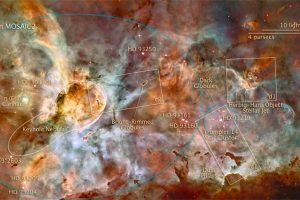Published by F. Damiani (INAF-OAPA) on A&A the first extensive spectroscopic analysis of the stellar population of a massive star forming region (Carina Nebula)

Star forming regions form stars in associations or clusters as a consequence of the gravitational collapse of clouds. Typically, in the Milky Way star forming regions form hundreds to few thousands of stars. However, there exist also very massive star forming regions which form tens to hundreds of thousands stars, together with some of the most massive stars known in the Universe.
The study of these very massive star forming regions is of particular interest for several reasons. For instance, they are quite common in starburst galaxies populating the early Universe, or they are the best laboratory to study how an environment very rich of both low-mass and massive stars can affect the star formation process and the early evolution of stars.
The Carina Nebula is one of the best studied massive star forming regions, the second closest (after Cygnus OB2) to the Sun. It is known that the region is forming a very large population of low-mass and massive stars, with more than 14000 members known to date, among which some of the most massive stars known. These stars are part both of a diffuse stellar population and of few massive clusters belonging to the Carina Nebula (such as Trumpler 14 and 16).
The study “Gaia-ESO Survey: Global properties of clusters Trumpler 14 and 16 in the Carina nebula” of the astronomer F. Damiani (Astronomical Observatory of Palermo), presents the first spectroscopic analysis of a large populations of stars (1085) associated to a massive star forming region. In particular, these stars are part of the clusters Trumpler 14 and 16 of the Carina Nebula. Thanks to the analysis of the data produced by the Gaia-ESO Survey, 286 new members are identified. Besides, it is presented a new detailed analysis of the morphology of the cloud and the spatial distribution of the stars associated to the Carina Nebula, together with the chronology of the star formation process in this region. Also rotation periods are calculated for most of these stars, with evidence that stars older than 3 million years rotate slower than younger stars.
The figure (link) shows a map of the Carina Nebula from CTIO and HST observations.
